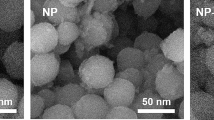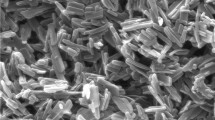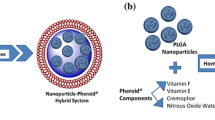Summary
The effect of surface charges on the cellular uptake rate and drug release profile of tetran-drine-loaded poly(lactic-co-glycolic acid) (PLGA) nanoparticles (TPNs) was studied. Stabilizer-free nanoprecipitation method was used in this study for the synthesis of TPNs. A typical layer-by-layer approach was applied for multi-coating particles’ surface with use of poly(styrene sulfonate) sodium salt (PSS) as anionic layer and poly(allylamine hydrochloride) (PAH) as cationic layer. The modified TPNs were characterized by different physicochemical techniques such as Zeta sizer, scanning electron microscopy and transmission electron microscopy. The drug loading efficiency, release profile and cellular uptake rate were evaluated by high performance liquid chromatography and confocal laser scanning microscopy, respectively. The resultant PSS/PAH/PSS/PAH/TPNs (4 layers) exhibited spherical-shaped morphology with the average size of 160.3±5.165 nm and zeta potential of–57.8 mV. The encapsulation efficiency and drug loading efficiency were 57.88% and 1.73%, respectively. Multi-layer coating of polymeric materials with different charges on particles’ surface could dramatically influence the drug release profile of TPNs (4 layers vs. 3 layers). In addition, variable layers of surface coating could also greatly affect the cellular uptake rate of TPNs in A549 cells within 8 h. Overall, by coating particles’ surface with those different charged polymers, precise control of drug release as well as cellular uptake rate can be achieved simultaneously. Thus, this approach provides a new strategy for controllable drug delivery.
Similar content being viewed by others
References
Zhang J, Yu B, Zhang XQ, et al. Tetrandrine, an antihypertensive alkaloid, improves the sleep state of spontaneously hypertensive rats (SHRs). J Ethnopharmacol, 2014,151(1): 729–732
Huang P, Xu Y, Wei R, et al. Efficacy of tetrandrine on lowering intraocular pressure in animal model with ocular hypertension. J Glaucoma, 2011,20(3):183–188
Ting CT, Li WC, Chen CY, et al. Preventive and therapeutic role of traditional Chinese herbal medicine in hepatocellular carcinoma. J Chin Med Assoc, 2015,78(3):139–144
Wu K, Zhou M, Wu QX, et al. The role of IGFBP-5 in mediating the anti-proliferation effect of tetrandrine in human colon cancer cells. Int J Oncol, 2015,46(3):1205–1213
Chen Y, Li P, Yang S, et al. Tetrandrine enhances the anticancer effects of arsenic trioxide in vitro. Int J Clin Pharmacol Ther, 2014,52(5):416–424
Chen T, Ji B, Chen Y. Tetrandrine triggers apoptosis and cell cycle arrest in human renal cell carcinoma cells. J Nat Med, 2014,68(1):46–52
Shi C, Ahmad Khan S, Wang K, et al. Improved delivery of the natural anticancer drug tetrandrine. Int J Pharm, 2015,479(1):41–51
Kreuter J. Nanoparticles—a historical perspective. Int J Pharm, 2007,331(1):1–10
Gelperina S, Kisich K, Iseman MD, et al. The potential advantages of nanoparticle drug delivery systems in chemotherapy of tuberculosis. Am J Respir Crit Care Med, 2005,172(12):1487–1490
Allen TM, Cullis PR. Drug delivery systems: entering the mainstream. Science, 2004,303(5665):1818–1822
Hillaireau H, Couvreur P. Nanocarriers' entry into the cell: Relevance to drug delivery. Cell Mol Life Sci, 2009,66(17):2873–2896
Faraji AH, Wipf P. Nanoparticles in cellular drug delivery. Bioorgan Med Chem, 2009,17 (8):2950–2962
Cho K, Wang X, Nie S, et al. Therapeutic nanoparticles for drug delivery in cancer. Clin Cancer Res, 2008,14(5): 1310–1316
Labouta HI, Schneider M. Tailor-made biofunctionalized nanoparticles using layer-by-layer technology. Int J Pharm, 2010,395(1–2):236–242
Reum N, Fink-Straube C, Klein T, et al. Multilayer coating of gold nanoparticles with drug-polymer coadsorbates. Langmuir, 2010,26(22):16 901–16 908
Author information
Authors and Affiliations
Corresponding author
Additional information
This project was supported by grants from the National Natural Science Foundation of China (No. 81101690), Natural Science Foundation of Hubei Province (No. 2014CFB403), and Applied Basic Research Foundation of Wuhan Science and Technology Committee (No. 2014060101010034).
Rights and permissions
About this article
Cite this article
Meng, R., Li, K., Chen, Z. et al. Multilayer Coating of Tetrandrine-loaded PLGA nanoparticles: Effect of surface charges on cellular uptake rate and drug release profile. J. Huazhong Univ. Sci. Technol. [Med. Sci.] 36, 14–20 (2016). https://doi.org/10.1007/s11596-016-1535-5
Received:
Revised:
Published:
Issue Date:
DOI: https://doi.org/10.1007/s11596-016-1535-5




